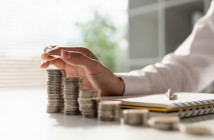Everybody knows that U.S. households’ savings soared after the pandemic struck, as the combined effects of checks from the government and fewer opportunities to spend swelled wallets. And everybody knows that as the checks stopped coming, the economy reopened and inflation began to bite, those savings got whittled away.
Now the question is how much of that cash is left, if any is left at all. The answer matters, first, because if Americans still have money sitting around, present-day consumer spending could be bolstered. Second, and perhaps more important, any remaining savings could make it easier for people to weather a rainy day. That would make a recession, if it comes, shallower, and lowers the chances of one occurring at all.
The easiest way to see what happened to savings in the wake of the pandemic is to look at the personal saving rate, which measures the share of after-tax income that doesn’t get spent. In April of 2020 it surged to 33.8%, which compared with 8.8% over the course of 2019. It stayed elevated throughout 2020 and most of 2021, but last year it was just 3.5%. This year it has only been a bit better, averaging 4.3%.
So one way that economists have tried to figure out how much “excess savings” are on household balance sheets—that is, savings beyond what one might expect people to have, going by prepandemic trends—is basically to add up all the after-tax income that didn’t get spent since the pandemic hit. One of the more pessimistic takes out there, from researchers at the Federal Reserve Bank of San Francisco, takes this approach. They calculate that excess savings peaked at about $2.1 trillion in August 2021, but by the second quarter of this year less than $190 billion remained, putting them on pace to be depleted in the current quarter.
Other economists get different answers. Goldman Sachs, for example, calculates that as of July there were $1.3 trillion in excess savings, an amount equal to about 5% of gross domestic product. That seems like a lot of dry powder for consumers, but the firm’s economists caution that different assumptions about what the level of savings would be now absent the pandemic can lead to big differences in how much excess savings there appears to be. Moreover, both the income and spending data are subject to revisions that can significantly swing the personal saving rate. The Commerce Department initially reported that the saving rate in 2012 was 3.9%, for example. Now the 2012 reading is 8.6%.
The Federal Reserve, meanwhile, has alternative measures of savings, based on changes in household assets and liabilities from banks and other sources. In particular, these show that savings deposits and other cash equivalents on household balance sheets came to $16.8 trillion in the second quarter, down from a first-quarter 2022 high of $17.5 trillion, but still up from the fourth-quarter 2019 level of $12.7 billion. Even after adjusting for inflation, that appears somewhat elevated relative to the pace of savings gains before the pandemic.
It matters, though, where these savings gains are. If they are mostly in the accounts of the very rich, for example, that would provide less oomph for consumer spending than if they were held by middle-class and poorer Americans. Distributional estimates from the Fed are problematic, as Fed economists have pointed out, because they rely on historical patterns of savings from before the pandemic. But data from Bank of America accounts suggests the increase in cash holdings has been relatively even, with median household savings and checking balances up by more than 40% relative to 2019 for low-, medium- and high-income households.
That is a reflection, says Bank of America Institute senior economist David Tinsley, of how a strong labor market has allowed people to keep spending without dipping too much into the savings they built up.
“It’s not like spending has been crazy,” he says.
By the same token, just because Americans generally seem to still have some of their pandemic savings left doesn’t mean they are going to burn through them—especially since those excess savings are now, by all measures, lower than they were. Instead, investors might better think of those savings as a buffer that will make it easier for people to absorb any adverse shocks.
Spending might not get much more of a tailwind, but the chances of a recession are diminished.




